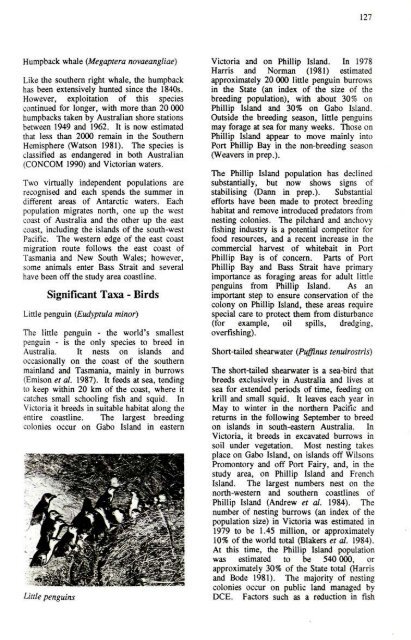Factors Affecting Flora Conservation - Victorian Environmental ...
Factors Affecting Flora Conservation - Victorian Environmental ...
Factors Affecting Flora Conservation - Victorian Environmental ...
Create successful ePaper yourself
Turn your PDF publications into a flip-book with our unique Google optimized e-Paper software.
127<br />
Humpback whale (Megaptera novaeangllae)<br />
Like the southern right whale, the humpback<br />
has been extensively hunted since the 1840s.<br />
However, exploitation of this species<br />
continued for longer, with more than 20 000<br />
humpbacks taken by Australian shore stations<br />
between 1949 and 1962. It is now estimated<br />
that less than 2000 remain in the Southern<br />
Hemisphere (Watson 1981). The species is<br />
classified as endangered in both Australian<br />
(CONCOM 1990) and <strong>Victorian</strong> waters.<br />
Two virtually independent populations are<br />
recognised and each spends the summer in<br />
dift'erent areas of Antarctic waters. Each<br />
population migrates north, one up the west<br />
coast of Australia and the other up the east<br />
coast, including the islands of the south-west<br />
Pacific. The westem edge of the east coast<br />
migration route follows the east coast of<br />
Tasmania and New South Wales; however,<br />
some animals enter Bass Strait and several<br />
have been off the study area coastline.<br />
Significant Taxa - Birds<br />
Little penguin (Eudyptula minor)<br />
The little penguin - the world's smallest<br />
penguin - is the only species to breed in<br />
Australia. It nests on islands and<br />
occasionally on the coast of the southem<br />
mainland and Tasmania, mainly in burrows<br />
(Emison et al. 1987). It feeds at sea, tending<br />
lo keep within 20 km of the coast, where it<br />
catches small schooling fish and squid. In<br />
Vicloria it breeds in suitable habitat along the<br />
entire coastline. The largest breeding<br />
colonies occur on Gabo Island in eastern<br />
Little penguins<br />
Victoria and on Phillip Island. In 1978<br />
Harris and Norman (1981) estimated<br />
approximately 20 000 little penguin burtows<br />
in the State (an index of the size of the<br />
breeding population), with about 30% on<br />
PhUlip Island and 30% on Gabo Island.<br />
Outside the breeding season, little penguins<br />
may forage at sea for many weeks. Those on<br />
Phillip Island appear to move mainly into<br />
Port Phillip Bay in the non-breeding season<br />
(Weavers in prep.).<br />
The Phillip Island population has declined<br />
substantially, but now shows signs of<br />
stabilising (Dann in prep.). Substantial<br />
efforts have been made to protect breeding<br />
habitat and remove infroduced predators from<br />
nesting colonies. The pilchard and anchovy<br />
fishing industry is a potential competitor for<br />
food resources, and a recent increase in the<br />
commercial harvest of whitebait in Port<br />
PhUlip Bay is of concern. Parts of Port<br />
Phillip Bay and Bass Strait have primary<br />
importance as foraging areas for adult little<br />
penguins from Phillip Island. As an<br />
important step to ensure conservation of the<br />
colony on PhUlip Island, these areas require<br />
special care to protect them from disturbance<br />
(for example, oU spills, dredging,<br />
overfishing).<br />
Short-tailed shearwater (Puffinus tenuirostris)<br />
The short-tailed shearwater is a sea-bird that<br />
breeds exclusively in Ausfralia and lives at<br />
sea for extended periods of time, feeding on<br />
krill and small squid. It leaves each year in<br />
May to winter in the northern Pacific and<br />
returns in the following September to breed<br />
on islands in south-eastern Ausfralia. In<br />
Victoria, it breeds in excavated burrows in<br />
soil under vegetation. Most nesting takes<br />
place on Gabo Island, on islands off Wilsons<br />
Promontory and off Port Fairy, and, in the<br />
study area, on Phillip Island and French<br />
Island. The largest numbers nest on the<br />
north-western and southern coasflines of<br />
Phillip Island (Andrew et al. 1984). The<br />
number of nesting burrows (an index of the<br />
population size) in Victoria was estimated in<br />
1979 to be 1.45 million, or approximately<br />
10% of die world total (Blakers et al. 1984).<br />
At this time, the Phillip Island population<br />
was estimated to be 540 OCX), or<br />
approximately 30% of die State total (Harris<br />
and Bode 1981). The majority of nesting<br />
colonies occur on public land managed by<br />
DCE. <strong>Factors</strong> such as a reduction in fish
















